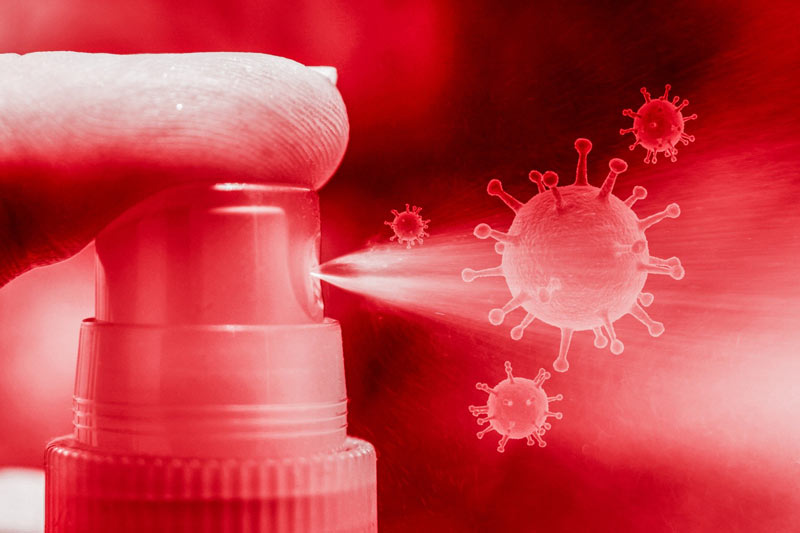Safe and Effective Ways to Properly Sanitize Your Two-Way Radios During COVID-19

 With the coronavirus pandemic impacting nearly every part of the world currently, there is a greater emphasis on hygiene and constant cleaning to reduce the risk of spreading the infection. Two-way radios are frequently used in hospitals and other clinical settings with higher than average rates of infection – making shared two-way radios a potential transmission source when they are not appropriately sanitized.
With the coronavirus pandemic impacting nearly every part of the world currently, there is a greater emphasis on hygiene and constant cleaning to reduce the risk of spreading the infection. Two-way radios are frequently used in hospitals and other clinical settings with higher than average rates of infection – making shared two-way radios a potential transmission source when they are not appropriately sanitized.
It is not certain how long the COVID-19 virus lives on surfaces, though studies have shown that it can live for hours, and perhaps even up to three days in certain conditions. Due to this, whenever sharing of two-way radios and accessories can be avoided, it should be. However, we understand that this simply isn’t an option for many organizations or users.
In an effort to increase the safety and prioritize the health of our customers, Bridge Wireless would like to offer some guidelines for adequately sanitizing two-way radios during the pandemic to minimize the risk of spreading the virus through the use of a radio. After an individual has finished using a radio and any accessories but prior to the use by another person, the following steps should be taken to ensure that it has been thoroughly sanitized.
- Preparation – The individual cleaning the equipment should thoroughly wash their hands using antibacterial soap for no less than 20 seconds per CDC guidelines or use hand sanitizer. The cleaning area or work desktop should also be sanitized regularly, including before and after cleaning any radios. This can be done using either a disinfectant wipe or spray with a clean cloth (cloths should only be used once before washing), or isopropyl alcohol.
Remember that when going through the next steps, you may opt to either wear gloves or continue to wash your hands regularly. It’s crucial not to touch your face at any time before the radios have been disinfected thoroughly, and the work area has been re-sanitized.
- Prepare the radios – Prior to cleaning them, the radios should be prepared, which includes removing the batteries, and any accessories.
- Wipe down the radios – Before disinfecting the radios, you may have to wipe them down, particularly if they are used in industries where dirt and debris may accumulate on them. Wiping off this initial contamination will allow the disinfectant to reach all hard surfaces adequately.
- Select a cleaning solution – Do not immerse the radios in any cleaning solution or spray the radios directly with a cleaning solution or use bleach-based disinfectant wipes as this can damage the equipment. It is best to use a disinfectant soap solution, diluted bleach (1:10), or wipe them with isopropyl alcohol.
- Disinfect the radios – Once the radios are wiped down, and the cleaning solution is prepared, you can disinfect them. You should apply whatever cleaning solution you are using with a soft, clean cloth. Carefully apply the solution to all areas without allowing any solution to enter the speaker or microphone openings. Once one radio is disinfected, set it on an uncontaminated part of the work surface while you disinfect the remaining ones. Do not touch the disinfected radios again until your hands have been washed, or you have changed gloves.
- Dry the radios – If you are using isopropyl alcohol to disinfect the radios, they will likely dry within minutes, and no additional actions will be required. However, if you used a bleach mixture or one with antibacterial soap, you may want to wipe them down with an additional damp cloth to remove any soap or remaining cleaning solution. Then dry them with a separate clean cloth or paper towel.
To ensure that the radios remain disinfected throughout the process, it is important to prevent cross-contamination. Do not let any unsanitized radios come into contact with those that have been disinfected. Do not touch any dirty surface with your hands or a cloth and then use that on a disinfected radio. Use new cloths at each step in the process and wash your hands frequently. Avoid touching your eyes, nose, and mouth with unwashed hands.
While the COVID-19 pandemic is incredibly scary, and particularly for many who are still in the workforce and may have to share equipment, it can be done safely by following the above steps. It’s important to take your time, though, which minimizes additional risk to those who are cleaning the equipment, and follow every step completely, which also minimizes the risk for the next user.
